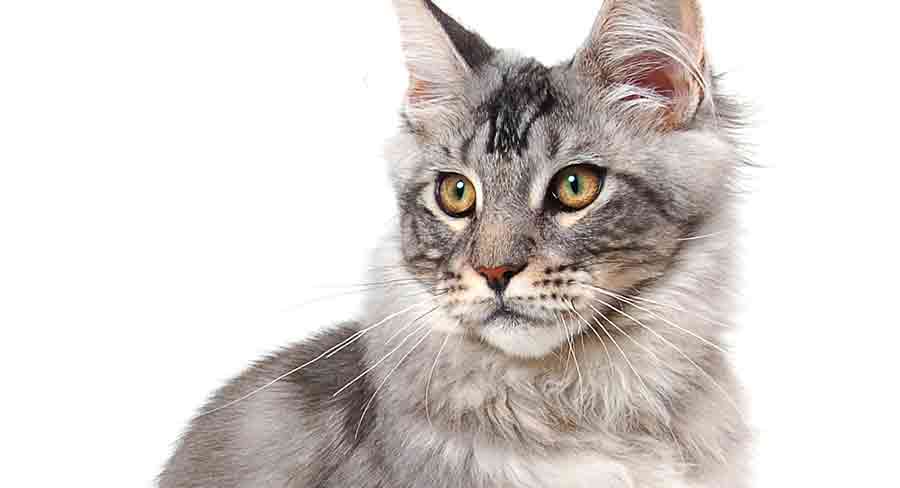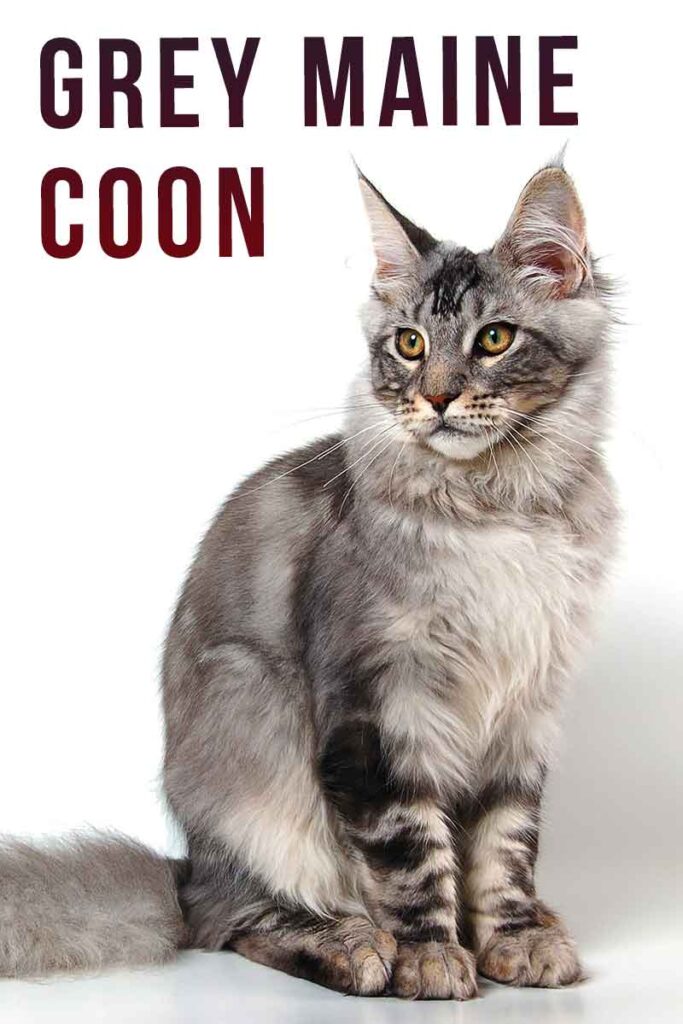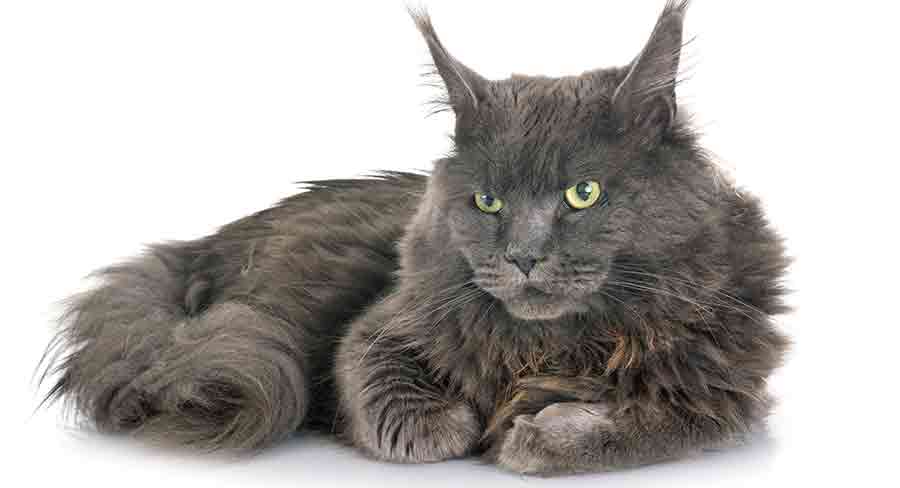
Are you ready to fall in love with the grey Maine Coon cat? Because you will do by the end of this article!
Grey Maine Coon kittens have the same amazing personality as Maine Coons of all other colors. Several shades of grey and grey patterns are possible in their coat, but you might be surprised how some of them are actually described on their pedigree certificate…
What is a Grey Maine Coon?
This isn’t a trick question. A grey Maine Coon is a Maine Coon cat with mostly or entirely grey fur. Grey Maine Coons are also described as gray Maine Coons, especially in North America. Both spellings are acceptable, but did you know that neither are technically accurate? In fact, a grey Maine Coon cat is more properly be described as either silver or blue!
Blue?!
Yes! Cat aficionados have their own terminology for describing some elements of cats’ appearance, and for that reason Maine Coons in light shades of grey are officially called silver, and darker shades of grey are properly known as blue. Blue is used by both cat and dog breed registries to describe animals with a deep, slate grey coat. Blue Maine Coons look like fairy tale beasts straight out of the pages of a folk story!

Grey tabby Maine Coons and other patterns
Not all grey Maine Coons have a solid grey coat. All of the following colors and patterns are possible according to the Cat Fanciers’ Association official breed standard:
- Solid blue. Dark slate grey all over.
- Blue and white. A dark grey and white Maine Coon, with mittens, bib, and white belly.
- Silver tabby. Black stripes on a light, clear cool grey background, like the one in the photo above. This is the only kind of black and grey Maine Coon.
- Blue silver tabby. An all grey tabby Maine Coon with dark grey stripes on a light grey background.
- Blue tabby. Dark grey stripes on a warm ivory-grey background.
- Tabby and white. Any of the above, with white paws, bib and belly.
- Blue-cream. Dark grey intermingled with patches of cream, resembling a faded tortoiseshell pattern.
- Blue-cream and white. Dark grey with patches of cream and white, resembling a fading calico pattern.
Notice that there’s no solid silver option – pale grey only appears as a background color on grey tabby Maine Coon kittens.
Another category of grey and white Maine Coon kittens are the chinchilla, shaded and smoke patterns:
- Cats with chinchilla silver and chinchilla blue silver coats have white fur with just a little black or grey pigment at the tip of each strand of fur. The overall effect is of a sparkling silver-grey coat.
- Maine Coons with shaded silver and shaded blue silver coats have a slight longer band of black or grey pigment and the end of each hair follicle. The overall effect is similar but perceptibly darker than chinchilla markings.
- Black and blue smoked Maine Coons have even deeper black or grey tips on their hairs. Sitting still, they look black or solid grey. But when they move, their white undercoat is revealed, creating an ethereal, hazy grey.
Grey Maine Coon Genetics
Lots of our readers have asked ‘are blue Maine Coons rare?’ and the answer is actually a bit more interesting than just yes or no. Grey coats are caused by dilution of black pigment in the cat’s fur. Color dilution like this is controlled by a gene called the dilute gene. Cats only have dilute coats when they inherit two copies of the dilute gene, one from each parent. Without selective breeding, this would make grey Maine Coon kittens rare. But, since breeding choices are actually made and controlled by breeders, it’s reasonably straightforward to engineer litters of grey and grey and white kittens.
Likewise, tabby, chinchilla, shaded and smoked patterns are controlled by known series of genes, so a competent breeder will be able to predict which combinations of tom cat and queen ought to produce grey tabby Maine Coon kittens.
Since pedigree Maine Coon breeding outcomes are so heavily decided by humans and not the cats themselves, the frequency of kittens in any given color is significantly dictated by how desirable and sought after that color is. But some less-than-scrupulous breeders might also imply that a color is hard to achieve, in order to charge a high grey Maine Coon cat price. Reputable breeders rarely charge extra for unusual colors, despite their rarity, because they know that doing so increases their appeal to kitten farms, and puts kittens at risk.
Grey Maine Coon Temperament
Maine Coons are big, friendly, giants of cats. Grey Maine Coon size can be over a foot tall, and up to 18 pounds. They tend to be very chatty and often stick close to their human family. However, they’re rarely described as lap cats, and often dislike being cuddled at all. Unlike most cat breeds, lots of Maine Coon owners report that their cats love water! Some people attribute this to their historic role as rat catchers on board merchant ships. Maine Coons are also very intelligent, and respond well to clicker training.
This personality profile is true of Maine Coons in all colors, including those with blue fur, and light grey tabby Maine Coon cats. Interestingly, one survey of people’s perceptions of cat behavior in 2015 found that grey and white cats were more likely to be described as aggressive at home, during handling, and at the vet. But they didn’t gather enough data to explain why that might be, and it could still turn out the results were a coincidence.
Grey Maine Coon Health
Before embarking upon life with any color of Maine Coon cat, it’s important to consider their health. Most grey Maine Coons will live to at least 12 years old. At the time of writing, there’s no evidence that their health or lifespan are affected by their color. By virtue of their breed, Maine Coons of all colors are more than averagely likely to be diagnosed with:
Heart disease
Between one quarter and one third of Maine Coons carry a faulty gene which causes the heart disease hypertrophic cardiomyopathy, where the heart muscle grows abnormally thick. Nutrition and rate of growth during kittenhood, larger body size and obesity may also increase the risk of a cat with the faulty gene going on to develop symptoms.
Orthopedic diseases
One of the perils of being a larger cat breed is an increased risk of joint problems. Specifically, 1 in 4 Maine Coons are diagnosed with some degree of hip dysplasia, a malformation of the hip joint which causes painful arthritis and sometimes even lameness. There are also diagnoses of elbow dysplasia and knee problems among Maine Coons.
Grey Maine Coon Grooming
A grey Maine Coon looks fabulous, but they can be high maintenance too. Like all cats, Maines will care for their coat fastidiously, and spend hours a day cleaning and straightening it. However, they have a lot of coat to get through, and some cats do struggle to keep on top of it. In particular, overweight cats, senior cats, and cats with joint diseases, who can’t comfortably reach all areas to groom them. To help keep your Maine Coon free of mats, tangles and debris, it’s wise to brush them with a slicker brush at least once a week. Starting while they’re a kitten can make this as painless as possible.

Your Grey Maine Coon
Grey is a striking colorway of the popular Maine Coon cat breed. It can be present as a solid dark slate color, or a bright silver background with tabby markings. And many other patterns besides. There’s some evidence that grey and white cats are more likely to be described as aggressive than other cats colors, but there’s still work to do to confirm if or why that is. If you choose a grey Maine Coon, they’re likely to have the same confident and sociable, but not soppy, personality as Maine Coons in any other color. If you’re buying a grey Maine Coon kitten, it’s important to choose a reputable breeder, and prioritise health over color.
Do you have a grey Maine Coon cat? Or do you think it should be gray Maine coon cat? Tell us all about them in the comments box down below!
Before you go
Don’t miss these excellent Maine Coon articles elsewhere on the site!
- Maine Coon Cats Information Center – A Guide To The Giant Cat Breed
- Baby Maine Coon Cat: Choosing And Raising Your Maine Coon Kitten
- How Much Are Maine Coon Cats – What Should You Expect?
- Best Cat Food For Maine Coon Cats
- Maine Coon Cat Names
- Pictures Of Maine Coon Cats
- Orange Maine Coon
- Blue Maine Coon
References
Cannas et al. Evaluation of Maine Coon cat behavior during three different management situations. Journal of Veterinary Behavior. 2020.
Freeman et al. Body size and metabolic differences in Maine Coon cats with and without hypertrophic cardiomyopathy. Journal of Feline Medicine & Surgery. 2012.
Fries et al. Prevalence of the Myosin-Binding Protein C Mutation in Maine Coon Cats. Journal of Veterinary Internal Medicine. 2008.
Gundler et al. Prevalence of myocardial hypertrophy in a population of asymptomatic Swedish Maine coon cats. Acta Veterinaria Scandinavica. 2008.
Kaelin & Barsh. Genetics of Pigmentation in Dogs and Cats. Annual Review of Animal Biosciences. 2013.
Maine Coon Cat Breed Standard. Cat Fanciers’ Association. 2016.
Orthopedic Foundation for Animals
Stelow et al. The Relationship Between Coat Color and Aggressive Behaviors in the Domestic Cat. Journal of Applied Animal Welfare Science. 2015.
Leave a Reply